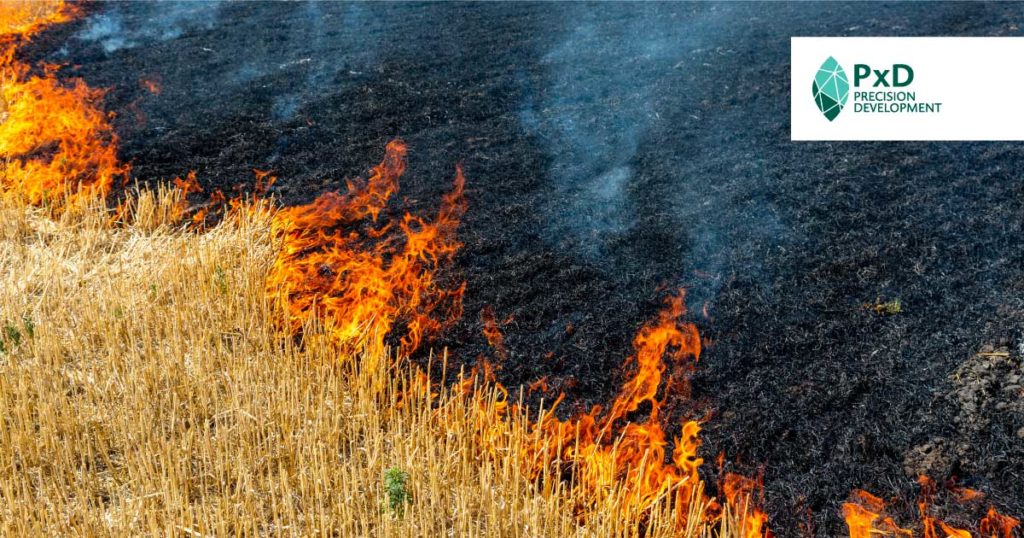Fighting Poverty through Climate Action
- November 18, 2021
- 13 minutes read
Last week delegates convened in Glasgow at the 26th Conference of the Parties (COP26) to the United Nations Framework Convention on Climate Change to engage in the difficult task of negotiating an offramp to climate catastrophe. The vast majority of PxD’s 5.2 million users are poor farmers who confront myriad – and reinforcing – challenges linked to climate change, food security, and poverty. We are excited to have secured new funding to pursue research opportunities for climate mitigation innovations to benefit smallholder farmers.

In this post Dina Rodrigues, Global Research Support Associate, Caitlin McKee, Assistant Director of Research, and Tomoko Harigaya, Chief Economist and Director of Research, present how PxD thinks about the complementarity of research, service design, service delivery, the evaluation of impact, and development practice. We assess how our programming can promote behavior change to advance climate-related goals, and we lay out opportunities for new research.
As we work to enhance our service offerings and research activities, to identify new opportunities for climate innovation, and to assist our users to lead more productive and resilient lives, we are guided by the following principles:
- User benefit first – Smallholder farmers cannot be expected to pay the price for climate mitigation. All climate-friendly advice to smallholder farmers from PxD should support livelihoods and not compromise agricultural yields or smallholders’ income. If there are evidence gaps on farmer benefit, we will explore ways for farmers to be favorably compensated for adopting those practices as an additional source of income.
- Adapt and mitigate – Our ambition is to promote both climate change adaptation (reducing potential damage) and mitigation (tackling the causes) activities.
- Replicate and scale – To fully leverage the advantages of scale, we work to ensure that our advisory services can be replicated across multiple contexts and with a diversity of partners.
The role of research at PxD
PxD’s systems are designed to scale the delivery of customized digital information to individuals and households so that they can act on it to improve their well-being and reduce exposure to risks and disasters such as floods and droughts. Our systems are designed to be scaled; as they scale, average costs fall and we improve the cost-effectiveness of our delivery.
Research is integral to this work. We deploy experiments and other research methods to inform the design of our services (innovation research) and to evaluate our impact (evaluation research). We generate evidence and insights based on a range of activities, from large randomized controlled trials to small-scale pilots. We learn from experiments that show statistically significant results and null experimental results, as well as through the analysis of descriptive and qualitative data.
PxD’s goal is to generate large aggregate impacts for the poor, and the role of research at PxD is to draw insights from empirical data, existing evidence, scientific knowledge, and theories to:
- Contribute to the development of PxD by identifying impact opportunities through the generation of insights into technological change, partnerships, scenario planning, and strategic choice, etc.
- Inform the design of programs and PxD’s investment decisions.
- Rigorously test and iterate ideas and assumptions.
- Evaluate and quantify the impact of our programs.
- Increase our understanding of the link between what we can observe and the ultimate outcomes we care about.
- Contribute to a broader knowledge base for practitioners, policymakers, and researchers.
In this way, our researchers support and collaborate with teams across the organization to enable efficient and effective learning through rigorous research to advance PxD’s goals.
Meeting the challenge of the age
We are intensifying our efforts to provide information to smallholder farmers that will allow them to make informed decisions to reduce the risks that climate change presents to their livelihoods and to enjoin their farming and land management activities in the fight against climate change. PxD is focusing on identifying interventions that can improve smallholder livelihoods whilst incorporating climate adaptation and mitigation efforts into our existing services. A key component of this is identifying feasible methods for measuring outcomes and program impacts on farmer welfare and the climate. A further component of our research agenda is to iteratively develop, refine, and test these innovations at scale.
Climate-smart advisory, adaptation, and mitigation efforts are already embedded into our programs across all the geographies we work in, as well as into the day-to-day agricultural activities that PxD farmers carry out. We focus both on climate change adaptation (reducing potential damage) and climate change mitigation (tackling the causes), as the activities and approaches are distinct.
1. Climate Change Adaptation
Adaptation efforts focus on anticipating the adverse effects of climate change and taking appropriate action to minimize potential damage for those most likely to be adversely affected, whilst managing and, hopefully, reducing climate-related risks. Ultimately, the aim of climate adaptation is to enhance the resilience of the individuals, households, and communities most vulnerable to negative climate shocks. These efforts generally involve the use of dynamic, local information to adapt their practices to climate shocks and behavior change and the adoption of new technology to increase resilience. At PxD we are increasingly asking questions such as: How climate-vulnerable are the farmers that use our services; What are the consequences of climate change that are affecting smallholder farmers’ lives; And how can we reduce the welfare loss that individual farmers and communities experience, or are likely to experience, because of climate change?
Weather uncertainty is one of the biggest agricultural risks faced by smallholder farmers. Climate change has increased weather variability and unpredictability in many parts of the world, imposing greater risks on agricultural production. These challenges are exacerbated by a lack of appropriate infrastructure and insufficient ground validation to provide accurate weather forecasts in many parts of the Global South.
PxD programs include adaptation efforts to reduce weather-related risk and uncertainty caused by climate change. One such example is the promotion of flood-tolerant seeds in the state of Odisha, India, on PxD’s largest Indian service, Ama Krushi, which currently has over one million users. Two-thirds of Ama Krushi farmers have experienced significant crop damage due to weather shocks and, of these, 57% experienced flooding. PxD’s climate adaptation efforts included experimentation with simplified, targeted Interactive Voice Response (IVR) messages to nudge the adoption of flood-tolerant rice varieties. We found that our simplified low-cost messaging significantly increased low and medium land types farmers’ adoption of flood-tolerant seeds. On average, these farmers were 2.6 percentage points more likely to plant flood-resilient seeds after receiving a message, a 25% increase over the control group mean adoption rate of 10.4%.
In another geographic context, in Punjab, Pakistan, PxD is working on new product design to further customize our advisory by integrating granular weather data into existing services. PxD will use enhanced weather models to inform farmers of local conditions, linking weather conditions to relevant agricultural advisory. Existing forecasts in Pakistan mainly lack both the granularity and the accessibility to meet the needs of smallholder farmers and support day-to-day farming decisions. Via partnership with experts in satellite-based weather prediction models, PxD will develop a granular forecast at the local tehsil level, and PxD will leverage its communication for behavior change expertise, disseminating this information via SMS and voice. In addition, we are conducting user research and consulting agronomists to design and test agricultural advisory that is linked to weather forecasts.
Finally, when weather calamities are anticipated, many PxD services advise farmers on what they can do to minimize crop damage. In Odisha and West Bengal, for example, our services inform farmers of impending cyclones, advise them about actions they can take to protect their crops in the field, or encourage them to bring in their produce from the field early, if appropriate. Our advisory can also promote appropriate post-harvest and storage practices in contexts where a farmer may otherwise not have expected to take action.
Example of paddy/rice crop advisory for deficit rainfall
English Translation:
Namaskar. Welcome to the ‘Ama Krushi’ free Agriculture Information service of Department of Agriculture, Government of Odisha. Paddy crop is affected by current scanty rainfall situation in many districts of Odisha. Today we will give some advisory to manage paddy crop due to scanty rainfall situation. Do not practice Beushaning in rice, if the crop is more than 45 days old. Don’t wait for rainfall and carry out hand weeding. In line direct sown paddy, use manual weeder if optimum soil moisture is present. Don’t go for Beushaning in areas where large deficit of rainfall has been seen. Go for hand weeding and gap filling using seedling of same age or clonal tillers to have a uniform distribution of plant after optimum rainfall is received. If basal fertilizer is not applied in direct sown paddy than apply 38-kg of DAP/acre, 20-kg of Urea/acre, 14-kg of MOP/acre., 4-kg of Borax/acre and 10-kg of Zinc Sulphate/acre. Strengthen the field bunds and close the holes to check seepage loss. For delayed transplanting seedlings up to 45 and 60-70 days old can be transplanted in case of medium and late duration rice varieties, respectively without much reduction in yield. Transplant the old seedling in puddled soil at shallow depth with closer spacing of 15 x15 cm and 4-5 seedlings per hill. Apply 50 % Nitrogen fertilizer along with other recommended fertilizer during transplanting. Thank You.
Example of paddy/rice crop advisory for excess rainfall
English Translation:
Namaskar. Welcome to the ‘Ama Krushi’ free Agriculture Information service of Department of Agriculture, Government of Odisha. Today we will discuss about some crop management strategies after excess rainfall due to low pressure and depression in Bay of Bengal. Drain out excess water from paddy field if possible. If the paddy crop is under submergence temporarily, apply 10-12 kg of MOP after rainwater recedes. Don’t apply fertilizer and wait for new tillers to come if paddy crop is affected largely due to complete submergence. If crop is lodged due to excess rain and wind, then try to keep it upright by binding few hills. There are chances of increase in chaffy grains if the crop is in panicle emergence stage. To minimize chaffy grains in the panicle spray Boron 20 % (Folibor/Solubor) @ 1-1.5 gram/litre or Borax @ 2-2.5 gram/litre of water. Spray fertilizers or pesticides during afternoon hours instead of morning hours if the crop is in flowering stage. Thank You.
2. Climate Change Mitigation
Mitigation efforts focus on tackling the causes of climate change to reduce the flow of heat-trapping greenhouse gases (GHG) and other climate and air pollutants, like black carbon soot, into the atmosphere. This can be achieved either by reducing emissions of climate pollutants or by increasing carbon sequestration in the soil, forests, and oceans. When it comes to smallholder farmers, climate mitigation focuses on changes in agricultural and land management practices and the adoption of new technologies or farming behaviors that can contribute to reducing emissions or increasing sequestration at scale. At PxD, we are increasingly preoccupied with ensuring that such behavior changes are also beneficial for the individual farmers and communities we serve.
Some agricultural practices are likely to contribute both to poverty alleviation and climate mitigation if they result in increases in agricultural outputs or income. One such example is promoting the optimal and timely application of nitrogen-based fertilizers. Most PxD advisory services, across our various geographies, include recommendations on the optimal application of planting and/or top-down fertilizer. Our agronomy teams have identified overuse of nitrogen fertilization and underuse of other required fertilizers with smallholders who tend to rice paddies and cotton fields in the Indian states of Odisha and Gujarat, respectively. Whilst nitrogen fertilization is an important component of crop production, crops can only efficiently absorb a finite amount of nitrogen. Nitrogen applied in excess contributes to water and atmospheric pollution in the form of nitrates or nitrous oxide. Emissions tend to be proportional to the amount of fertilizer used and the concentration of nitrogen in the product. Precise application of nitrogen fertilizers has the potential to cut down farming costs if farmers need to purchase less fertilizer, hence improving smallholders’ agricultural income whilst curbing nitrous oxide emissions. We are exploring user-friendly tools, such as leaf color charts, to support farmers to optimize their fertilizer application.
In addition, several of our services in Africa, including MoA-Info in Kenya, push-calls in Nigeria, and UCAT-Uganda, advise farmers to cover crops to slow erosion, improve soil moisture, and prevent pests and disease outbreaks. PxD farmers across most of our geographies also control soil erosion via techniques such as terracing or contour plowing. These methods are likely to improve yields via a general enhancement of soil conditions whilst increasing soil propensity for carbon sequestration by slowing erosion.
However, some agricultural practices have unclear effects on yields, agricultural income, or climate outcomes. Most worryingly, many behavior changes that present opportunities for climate mitigation put a burden on smallholder farmers. In these cases, decision-makers, researchers, and practitioners must identify ways to compensate farmers for the social benefits they generate by adopting those behavior changes, whilst guaranteeing an immediate private return for early adopters. This may include payment schemes, such as conditional cash transfers, or subsidies for improved technologies, but further research is needed to understand what kind of incentives and measurement techniques are likely to work in various settings.
Opportunities for new research
In partnership with the Institute for Governance & Sustainable Development (IGSD), PxD will undertake exploratory activities with a specific focus on climate change mitigation in addition to poverty alleviation. We are excited to scope our existing programs and partnerships to identify:
- Opportunities for scalable climate mitigation innovations.
- Evidence and measurement gaps.
- How we can leverage soil science, remote sensing, and soil sensor technology to improve agricultural productivity and generate climate mitigation innovations.
- Barriers and opportunities in terms of measurement, adoption, and smallholder behavior change.
The aim of this work is to lay a foundation to ultimately develop, test, and scale innovations such as payment schemes or cash-transfer approaches that can simultaneously address climate change and reduce poverty.
On a preliminary basis, we have identified the following potential climate mitigation areas:
- Reducing black carbon emissions from crop or biomass burning
- Reducing nitrous oxide emissions from fertilizer overuse
- Enhancing soil carbon sequestration
- Protecting and enhancing carbon sinks through forestry
- Reducing methane emissions from livestock, dairy, and rice.
Within each of these areas, PxD plans to scope relevant agricultural activities practiced by farmers engaged with our advisory services across all our geographies, relevant partner capabilities, and potential external consultants. Based on this mapping exercise, we aim to identify specific technologies and farming practices that can improve climate mitigation outcomes at scale in conjunction with relevant measurement outcomes (e.g., soil carbon, soil characteristics, and GHG and climate pollutant emissions reductions).
PxD is committed to always putting the welfare of smallholders and our contribution to poverty alleviation first. As an organization that works with over five million users across a variety of settings, PxD is well-placed to advance the knowledge frontier through rigorous experimental applied research. Our aim is to enhance the resiliency of smallholder farming households through the diffusion of information to promote the adoption of new technologies and climate-smart agricultural practices. We are excited to implement this nascent research agenda and enjoin the activities of millions of smallholders as agents of change in plotting a more resilient future.
We will share our learnings in future posts!


Stay Updated with Our Newsletter

Make an Impact Today


